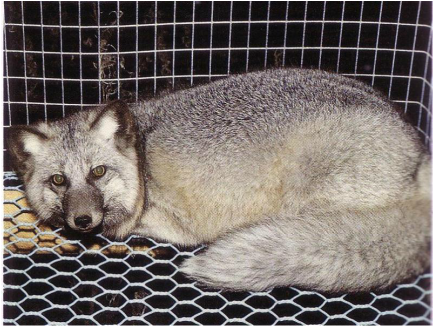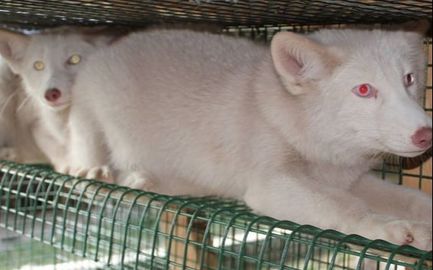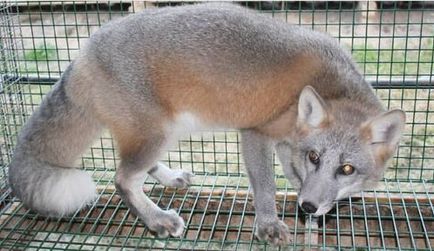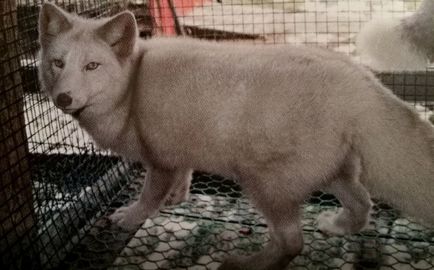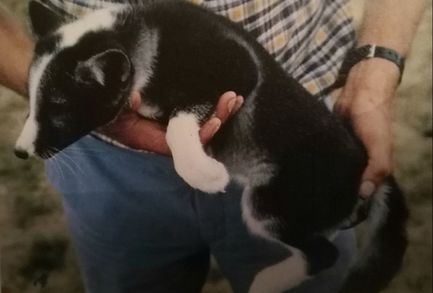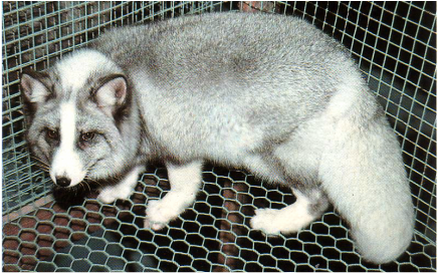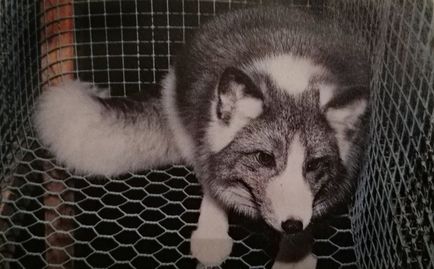What are hybrid foxes?
Hybrid foxes are the result of the mating between an arctic fox (Vulpes lagopus), generally female, with a red fox (Vulpes vulpes), generally male. Hybrids are generally created through artificial insemination on fur farms, the first known reported case being from 1929. Male reds are usually used to inseminate arctic vixens, as arctic foxes have significantly larger litters than red foxes, which, in turn, is more profitable for fur farmers. There have been reports of hybrid fox kits occurring in the wild, but such matings (arctic x red) are not a common occurrence as the two species are natural enemies in the wild, with red foxes often killing and eating arctic fox kits as well as competing with them for food and territory. Hybrid foxes can come in several different color mutations, depending on the coloration of the red and arctic parents. Hybrid foxes are quite uncommon in the exotic pet trade. They are born sterile, meaning they cannot reproduce. It is said that they are aggressive by nature, but since only a handful of individuals have been known to have hybrid foxes as pets, all which were raised and handled from a very young age, that claim has yet to be validated. Their vocalizations are similar to those of red foxes. When happy, they do a soft cooing, and when scared or upset, they do the familiar gekkering sound that's specific to red foxes.
There is documentation stating that hybrids between gray foxes (Urocyon cinereoargenteus) and red foxes (Vulpes vulpes) created through artificial insemination once existed in captivity, decades ago, but no pictures or detailed information regarding those 'hybrids' could be found, so it is unsure whether they truly did exist or whether they were just the part of somebody's imagination. Little information on gray/red fox hybrids here.
This page will only show the colour mutations of hybrid foxes which have been documented, either through pictures of through text. There may be other mutations of hybrid foxes out there as the combinations can be endless, considering how many colours red foxes and arctic foxes come in, but if there are, there has been no documentation on any of them. Keep in mind that if you want a hybrid to be golden or red, you must use a polar arctic fox and never a blue arctic fox, as the polar gene, unlike the blue gene, allows the red colour to express itself on the fox's fur.
There is documentation stating that hybrids between gray foxes (Urocyon cinereoargenteus) and red foxes (Vulpes vulpes) created through artificial insemination once existed in captivity, decades ago, but no pictures or detailed information regarding those 'hybrids' could be found, so it is unsure whether they truly did exist or whether they were just the part of somebody's imagination. Little information on gray/red fox hybrids here.
This page will only show the colour mutations of hybrid foxes which have been documented, either through pictures of through text. There may be other mutations of hybrid foxes out there as the combinations can be endless, considering how many colours red foxes and arctic foxes come in, but if there are, there has been no documentation on any of them. Keep in mind that if you want a hybrid to be golden or red, you must use a polar arctic fox and never a blue arctic fox, as the polar gene, unlike the blue gene, allows the red colour to express itself on the fox's fur.
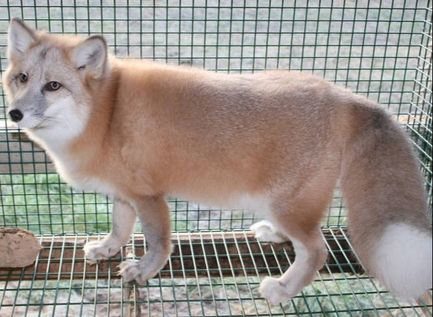
Golden island fox (fire gold fox)
Golden island foxes are hybrids resulting from the breeding of a standard silver fox with a polar arctic fox. This hybrid was first created in 1941, though there's been previous accounts of them naturally occurring in the wild, in Iceland. As kits and in the summer, their coloration strongly resembles that of polar arctic fox kits or blue frost hybrids. However, as winter arrives, they lighten up, slowly turning golden or red, depending on the type of silver fox used. Their muzzle, legs and tail are grey, complimented by some grey highlights that most individuals keep on their lower back. The guard hairs on their belly are white, while their ears are black or grey. Their nose is black and their eyes, brown or yellow. Breeding any type of gold fox to a polar arctic fox will result in the same mutation, the earlier onset of their color change being the only difference. Picture of a golden island fox in summer coat & picture of a golden island fox kit. Picture source: FinnishFurAnimals. |
Northern light fox
Northern light foxes are hybrids resulting from the combination of an Alaskan silver fox with a polar arctic fox. These hybrids strongly resemble polar arctic fox kits when they are kits themselves and when they are in their summer coat. Their winter coat is light grey, with the extremities being darker (dark grey or black muzzle, ears and legs). The sides of their bodies and their rear is pale golden. These hybrids have a black nose and generally, brown or yellow eyes. Northern light foxes strongly resemble darker golden island foxes. Picture of a golden island fox as a kit (the darker one in the background is the northern light fox kit; the kit in the foreground is a golden island fox). Picture source: CRAAQ, Élevage du renard (copy I own of the book). |

Blue frost fox
(indigo, bluesilver fox) The blue frost fox, also known as bluesilver fox or indigo fox, is created through the mating of a silver fox to a blue arctic fox. Crossing any kind of gold or cross fox to a blue arctic will produce the same coloration. The hybrid resulting of this mating closely resembles a silver fox (Vulpes vulpes). It has the shorter legs, rounder ears, larger muzzle and fur texture of the arctic's but is larger in size, has the long, white-tipped tail of the red fox and the coloration of a silver fox. Some individuals have a tint of grey, resembling an extremely dark blue arctic fox. Their nose is black and their eyes, brown or yellow. Picture source: CRAAQ, Élevage du renard (copy I own of the book). |
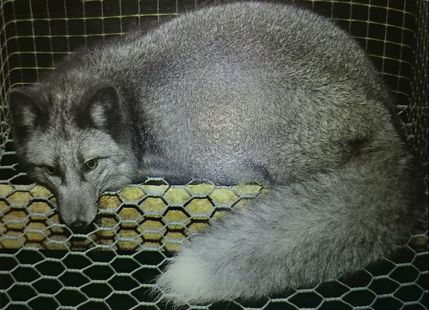
Pale blue frost fox (pale indigo, pale bluesilver fox) The pale blue frost fox is a result of the combination of a burgundy type of red fox or of any type of pearl fox with a blue arctic fox. The resulting hybrids are considered bluesilver (indigo) foxes and will look as such, too, minus the fact they will have a slightly lighter shade, caused by the dilution gene of the burgundy or pearl fox they were created from. Their eyes are either brown, yellow or green and their nose, grey or black. Picture source: Beautiful Fur Animals and Their Colour Genetics, Scientifur (copy of the book I own). |
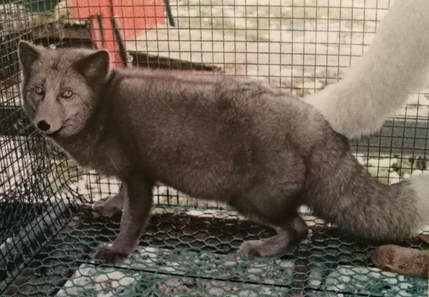
Amberfrost fox
Contrary to what its name may lead to believe, the amberfrost fox, also known as pearlfrost or pastelfrost fox, results from the combination of the Polish pastel red fox with the arctic pearl brown mutant; it has no relation to the true amber fox. Amberfrost foxes are born solid brown; a rich, vibrant brown resembling the cinnamon fox, which later turns, as the fox matures, into a dark, grey-like brown strongly resembling that of the pastel fox it comes from. They have the coat type of the arctic fox and some of the physical traits of the arctics, combined with the size and tail of the red fox. Their eyes are exclusively blue, paired with a brown, reddish or grey nose. Picture source: Beautiful Fur Animals and Their Colour Genetics, Scientifur (copy of the book I own). |

Platinum bluesilver fox
The platinum bluesilver fox hybrid is a direct result of the combination between a red fox of the platinum colour mutation and a common blue arctic fox. Platinum bluesilver foxes have the general appearance of a common platinum fox (Vulpes vulpes) with the face, texture of the coat and feet of the arctic fox, but tail and size of the red fox. Due to the platinum factor, the grey is diluted, making it considerably pale, especially as the fox matures and begins to grow its guard hairs. The platinum bluesilver fox has a black nose. Its eyes can be either brown, yellow or green. Picture source: Fur farm in Quebec, Canada. |
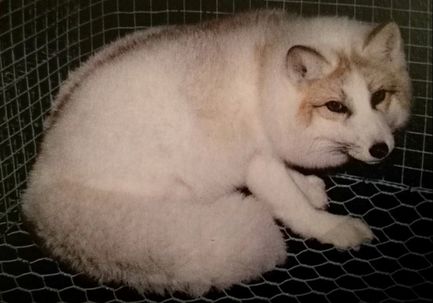
Arctic golden island fox
(golden marble fox) The arctic golden island fox, also known as the golden marble fox fox, is the direct result of the combination of either a standard silver marble fox or a red marble (sun glow) fox with a polar arctic fox. The resulting fox hybrid will strongly resemble the sun glow (red marble) fox color mutation found in the red fox species. The only differences are the texture of the fur, which is that of an arctic fox, the shorter, larger muzzle of an arctic and certain other physical traits which will closely resemble those of arctic foxes. The eyes of golden marble foxes are either brown or yellow and their nose, black. Picture source: Beautiful Fur Animals and Their Colour Genetics, Scientifur (copy of the book I own). |
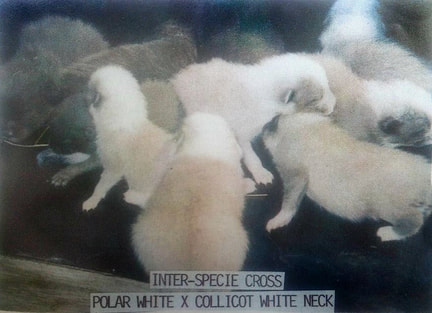
Colicott frost platinum fox
The colicott frost platinum fox is the direct result of the combination of a rare colicott whitemark or colicott platinum fox with a polar arctic fox. The resulting hybrids vary in colors. Some (at left in the picture) are dark brown/grey and resemble polar arctic fox kits. Those kits will grow up to resemble a blue arctic fox, but rather than having grey-tipped white fur like a blue arctic fox, theirs will be brown. The other kits (at right) resemble the colicott whitemark fox, however, much lighter. Some grow up to be extra pale while others stay darker, even keeping dark grey or brown markings on their feet. Those kits will grow up to resemble a pale burgundy platinum fox, with one exception: only the tip of their fur will be brown; underneath, all will be white (like a smokey cat). Their eyes are generally yellow, green or brown and their nose, black, reddish-brown or brown. Picture source: Silver Fox News, July-August 1968 edition. |
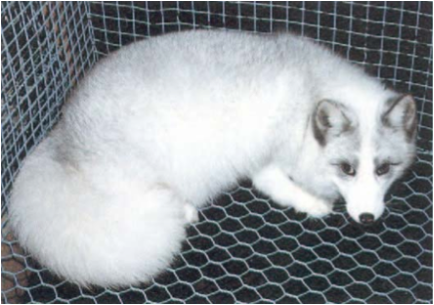
Shadowplatinum fox
The shadowplatinum fox, also known as the platinum blue frost fox, is the direct result of the combination between a red fox of the platinum colour mutation (or any other of the types of platinum seen in red foxes) and a shadow arctic fox. The hybrid resulting of this cross strongly resembles the glacier blue fox (Vulpes vulpes) with its extremely pale grey coat. It has the face, rounder ears, shorter legs and fur texture of the arctic fox but with the larger size and longer, fluffier, white-tipped tail of the red fox. Shadowplatinum foxes are sometimes born white and develop their coloration as they mature. Their nose can be pink, black or black with pink dots and their eyes, brown, yellow, grey or green. Picture source: CRAAQ, Élevage du renard (copy I own of the book). |

Shadow red fox
The shadow red fox is a hybrid fox resulting of the direct combination of a silver platinum or cross platinum fox with a polar arctic fox. Shadow red foxes strongly resemble platinum red foxes (Vulpes vulpes) in their pattern of coloration. They have certain physical features of the arctic fox, such as the texture of their fur, their muzzle and their legs, and others of the red fox, such as their tail and size. They generally have brown or yellow eyes but can be seen having heterochromia or partially colored eyes. Their nose can be black, pink or black with pink spots. Picture source: US Fox Shippers Council. |
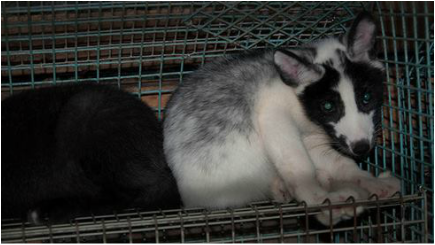
Blue arctic marble fox
Blue arctic marble foxes are the direct result of the crossing of either a silver marble fox or a red marble (sun glow) fox with a common blue arctic fox. They strongly resemble silver marble foxes (Vulpes vulpes), but they have certain physical traits of the arctic fox, such as the shape of the muzzle, the texture of the fur and the shape of the face, among others. Like all types of fox hybrids, they tend to be larger than arctics, being closer or identical in size with red foxes. Blue arctic marble foxes can have brown or yellow eyes paired with a black nose. Additional picture of a blue arctic marble. Picture source: A fur farm in Finland. |
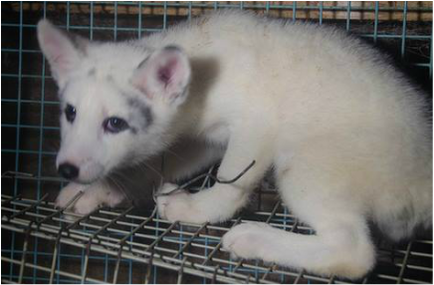
Shadow marble fox
(Shadowplatinum marble fox) The shadow marble fox hybrid is the direct result of the crossing of a silver marble fox or a red marble (sun glow) fox with a shadow arctic fox. Some individuals are born white, with their markings appearing only shortly after birth, while they are still young kits. They generally have markings around the ears, eyes and on their forehead. Their eyes can be brown, yellow, bi-eyed, blue or partially colored and their nose, black, pink or black with pink spots. Picture source: A fur farm in Finland. |
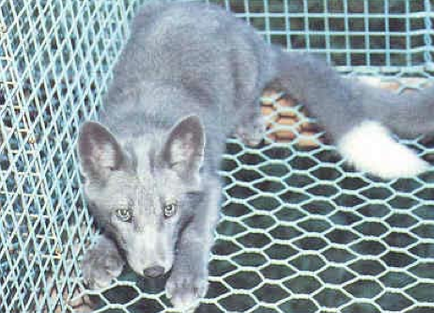
Sapphire frost fox (dawn sapphire fox)
The sapphire frost fox is a hybrid resulting from the combination of a Swedish sapphire or Oppdal sapphire arctic fox with any type of red fox, though usually pearl mutations are favored in this crossing. The first ones of this kind were produced in Finland in 1984 from a snow dawn red fox and a Swedish sapphire arctic fox. It strongly resembles the sapphire fox (Vulpes vulpes) but the texture of its fur is that of the arctic fox, along with the shape of the face and certain other physical characteristics. The coloration of their fur is also slightly darker than that of a common sapphire red fox, though much more blue than that of the arctic sapphire mutations. Like all other hybrids, they have the white-tipped tail and the size of the red fox. Being easier to produce than true sapphire V. vulpes, they, for a long time, replaced the latter in the fur industry. Their nose can be black or grey and their eyes, brown, yellow, green, blue or grey. Picture source: CRAAQ, Élevage du renard (copy I own of the book). |
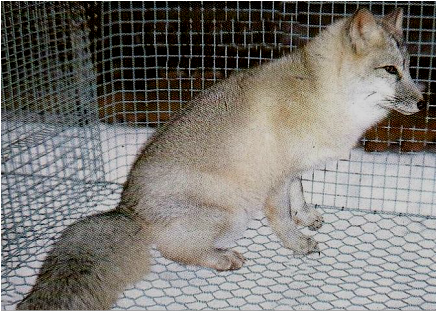
Fawn light fox
The fawn light fox is a very interesting hybrid fox which, color wise, strongly resembles the swift fox and the corsac fox, two species to which it is not even remotely related! This rare hybrid was created accidentally in 1983 by crossing a fawn glow fox (Vulpes vulpes) to a polar arctic fox (Vulpes lagopus). Hybrids of similar colors can be created by crossing a colicott fox or any fire types, snow glow included, with a polar arctic. Its belly, chest and sides are an extremely pale gold/cream color which blends in nicely with the rest of the fox's coloration; a very pale grey, sometimes marked by beige on the lower back. It has the feet size and shape, facial shape and fur texture of the arctic fox but the larger size and fluffy, white-tipped tail of the red fox). Its eyes can be brown, yellow, grey or green and its nose, black or grey. Picture source: eau. |
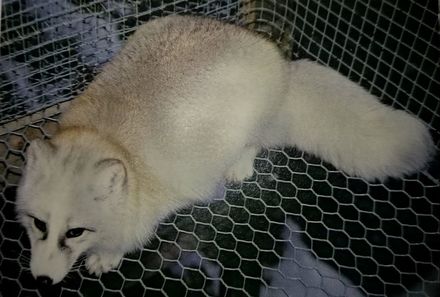
Golden island shadow fox
The golden island shadow fox is a hybrid resulting from breeding any variant of the silver fox (except the Alaskan silver, which would result in a northern light shadow fox) with a shadow arctic fox. The resulting fox has the coloration of a golden island hybrid fox (see first picture on this page for reference on the golden island fox) but with white, very large patterns similar to those of platinum red foxes (white feet, white belly, white chest, white muzzle, white blaze across the face). Their coloration is also diluted and further lightened up due to the platinum gene, making them appear almost white on their sides. Their eyes are generally brown, yellow or bi-eyed and their nose, black or black with pink spots. Additional picture here (pelt). Picture source: Beautiful Fur Animals and Their Colour Genetics, Scientifur (copy of the book I own). |
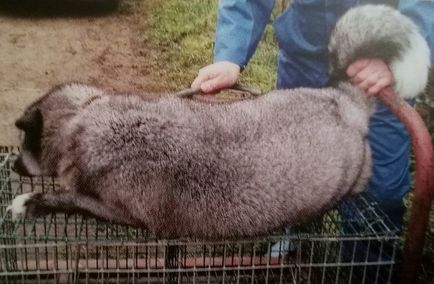
Iceblue northern light fox
The iceblue northern light fox is the direct result of the combination of a iceblue red fox or an Alaskan silver fox expressing the iceblue gene with a polar arctic fox. The hybrid resulting from this combination strongly resembles the northern light fox, though its coloration will be more bluish-grey tinted. Picture source: Beautiful Fur Animals and Their Colour Genetics, Scientifur (personal copy of the book). Icegold golden island fox This hybrid is the result of an icegold x white polar fox crossing, resulting in a fox that, color wise, is inbetween the golden island and the sapphire gold fox. |

Polarplatinum fox
The polarplatinum fox, also known as the platinum polar fox, is the direct result of the combination of a platinum fox (or any other platinum type) with a polar arctic fox, the natural mutation of the arctic fox. Polarplatinum foxes are completely white with the exception of a black stripe going from their shoulders down to their rear and stopping right before the tail starts. The stripe down their back can be medium grey or light grey, too. Their eyes are brown or yellow and their nose, black. Polarplatinum hybrids are not commonly created as their fur is not considered valuable in the fur industry.
Picture (of unknown source - if this is your picture and you want it down, contact me to let me know) shows an arctic fox with a coloration similar to what has been documented on polarplatinum foxes. Hope it gives an idea of what they look like! Real polarplatinum fox pelts here.
The polarplatinum fox, also known as the platinum polar fox, is the direct result of the combination of a platinum fox (or any other platinum type) with a polar arctic fox, the natural mutation of the arctic fox. Polarplatinum foxes are completely white with the exception of a black stripe going from their shoulders down to their rear and stopping right before the tail starts. The stripe down their back can be medium grey or light grey, too. Their eyes are brown or yellow and their nose, black. Polarplatinum hybrids are not commonly created as their fur is not considered valuable in the fur industry.
Picture (of unknown source - if this is your picture and you want it down, contact me to let me know) shows an arctic fox with a coloration similar to what has been documented on polarplatinum foxes. Hope it gives an idea of what they look like! Real polarplatinum fox pelts here.
|
Platinum blue cross fox (sapphire gold platinum fox, sapphire cross platinum fox)
The platinum blue cross fox results from the combination of any red fox (Vulpes vulpes) of the pearl and platinum gene with a polar sapphire arctic fox (or a sapphire arctic fox carrier of the polar gene). This hybrid fox has the overall coloration of the sapphire gold hybrid fox (see previous post for reference), but with the white pattern of the platinum red fox (white feet, white muzzle, white blaze on the forehead and white belly). They have a white-tipped tail like all hybrid foxes, and their eyes are either brown or yellow, with a black nose. Their coloration is more dilute than that of the sapphire gold fox due to the platinum gene, therefore appearing even lighter than the latter. Shadow amberfrost fox
The shadow amberfrost fox is the result of combining a Polish pastel fox with a shadow fox carrier of the arctic pearl gene. The resulting mutant is a very pale, nearly white fox with pale brown on its back and tail. Its eyes are usually golden, brown or green and its nose, black. |
Fawn light shadow fox
The fawn light shadow fox is identical, color-wise, to the fawn light fox and is created by combining either of the red fox types used for the fawn light fox, with a polar arctic fox expressing the shadow arctic gene or with an actual shadow arctic fox. Due to the shadow factor, the fawn light shadow fox will only be slightly paler than the fawn light fox, but seeing as the fawn light is already very pale to begin with, the difference is not that noticeable. Northern light shadow fox
The northern light shadow fox is the result of the combination of an Alaskan silver fox with a shadow arctic fox. This hybrid has the overall coloration of the northern light fox (see second hybrid fox shown on this page for reference), combined with very large white markings on its body (white feet, white muzzle, white blaze across the forehead and white belly) given to it by the shadow arctic fox gene, which makes the northern light shadow fox appear mostly white. Its eyes can be brown, yellow or bi-eyed and its nose, black or black with pink spots. |
